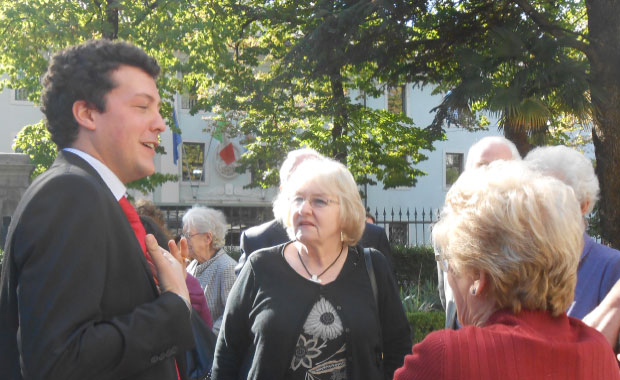Photo Guidance

Photo Guidance – Quick Guide
Nowadays, with most of us owning or having use of a digital camera, we tend to go on snapping away taking hundreds of photos, not worrying about wasting precious film. However, one of the side effects of this has been that a lot of us now take less time over planning our photographs, and can end up being disappointed by the end result.
The photographs you take on a twinning visit are a really important part of the trip. They act not only as a visual reminder of your experiences, but they are also crucial in helping the wider congregation/presbytery/community learn about your trip, and about their twinned congregation. Although not everyone involved in a twinning will get to go on a trip to visit their twin, photos can help to bring people closer together – by putting faces to names, seeing pictures of the life of the congregation, and understanding a little more about the physical environment in which the twin is situated.
It is really important to take time over your photos, and to spend a little bit of time thinking about the sort of photos you would like to be able to show when you return to your home congregation.
We at World Mission also find it really useful to have copies of your photos. It is great to have good quality photos to use for presentations to groups that are considering twinning, or to use in printed resources for twinning.
Local photographer Sarah Peter's has put together a handy guide to help you get the most from your camera, and to help ensure that your photographs are a wonderful memento of your twinning visit.
Composition
- Try and use a viewfinder, to help you walk around and find the shot. Remember, don't just stand at your height, bend down, lie down or find a high vantage point it all makes a difference. Try and include some foreground interest, to help lead your eye into the photo, it makes a difference
- Try and use the rule of thirds for a balance photo but rules are there to be broken
- The basic principle behind the rule of thirds is to imagine breaking an image down into thirds (both horizontally and vertically) so that you have 9 parts
- With this grid in mind the 'rule of thirds' now identifies four important parts of the image that you should consider placing points of interest in as you frame your image
The Rule of Thirds
The theory is that if you place points of interest in the intersections or along the lines that your photo becomes more balanced and will enable a viewer of the image to interact with it more naturally.
Studies have shown that when viewing images that people's eyes usually go to one of the intersection points most naturally rather than the centre of the shot – using the rule of thirds works with this natural way of viewing an image rather than working against it.
Framing Images
While adding points of interest to a foreground is an important technique for adding interest to landscape shots - a similar technique is to frame the shot by adding interest to other parts of the edges of an image.
Using diagonal lines can be a very effective way of drawing the eye of those viewing an image into it and to the main focal point. The lines need not be actual lines they could be the shape of a path, a line of trees, a fence, river or any other feature.
Lead In Lines
Use natural lines in your photo such as fences or paths to lead the eye into a photo.
Technical
Why not try not using the AUTO setting
With a digital camera, you have the freedom to take many photos, so experiment. Go out and turn your camera off auto, be brave and get used to using some of the other settings on your camera.
- Once you have tried it and practised, it becomes second nature, don't be scared to turn those dials
- You can use the pre-programmed modes such as macro, portrait, and sport to start your move away from auto
- Just use them in the right situation, try it
- If you are out turn it to landscape mode, take some shots, see how they differ from auto
- If you are photographing your pets or your kids, turn it to portrait mode and see what happens
Like anything, by getting used to your camera and its settings you will soon gain confidence
 >
>
Your Camera's Programmes
The number and type of exposure or shooting modes on a camera varies between manufacturers and between camera models.
Broadly speaking they are divided into three sections: Auto mode, Scene Modes and the P, A, S and M modes. Once you have tried it and practised, it becomes second nature, don't be scared to turn those dials
Auto
Think of the green square as the snapshot mode, where the camera will make all the decisions for you, not only regarding exposure settings but also ISO and whether the flash fires etc.
Flash Off Mode
This works in the same way as full Auto, but ensures the flash does not fire. This is useful for shooting in locations where flash photography is not allowed.
Portrait
This sets the widest aperture suitable for the lighting conditions to restrict depth of field and blur backgrounds. So f2.8 etc
Landscape
Small apertures are selected to give maximum depth of field (f22), which often results in slow shutter speeds, so best to use a tripod.
Close up Macro
Large apertures are selected here as the camera tries to increase the depth of field
Sports
Sets a fast shutter speed along with continuous AF and drive modes in order to capture sharp photos of moving objects. ISO may be pushed higher than desired.
Night Portrait
Flash will be used to illuminate the subject while a slow shutter speed captures he colour and detail of surroundings. If you are using a pop up flash you will need to be close to the subject.
P Mode
Also known as the Programmed Auto Exposure, this sees the camera pairing aperture and shutter speed based on its exposure reading. You can then shift these settings if you wish.
Aperture Priority Mode
You set the aperture and the camera sets the shutter speed for you. This mode is great for control over depth of field.
Shutter Priority Mode
You set the Shutter speed and the camera sets the aperture for you. This mode is ideal if you want to freeze action or create motion blur with a slow one.
Manual mode
Let's you adjust both the aperture and shutter speed for complete control and the camera won't change these even if the light changes. Good for flash lighting and panoramas.
Photographer's Top Tips
- Think about what you are going out to photograph?
- Hold your camera correctly and keep it steady
- Try and look at the weather forecast if you are going out and prepare for everything you might need
- Make sure your batteries are fully charged
- Check you have enough memory cards
- Give your lenses a clean
- Will you need a tripod?
- Have a cloth for wiping your camera if its wet
- Think about the light, where people are positioned, move into the shade if you can
- If you are going out to take landscape shots, remember the light. Midday sun always gives a harsh flat light, try and catch the 'magic hour' at sunrise and sunset, its worth the effort
- If you are photographing indoors at a party have spare batteries for your camera and flash
- Finally, try and be prepared, it makes for an easier day out and helps you concentrate on taking the photos